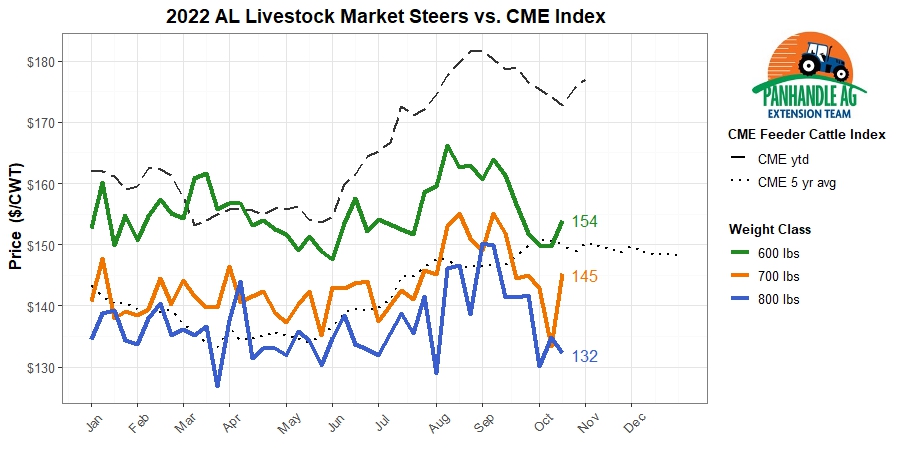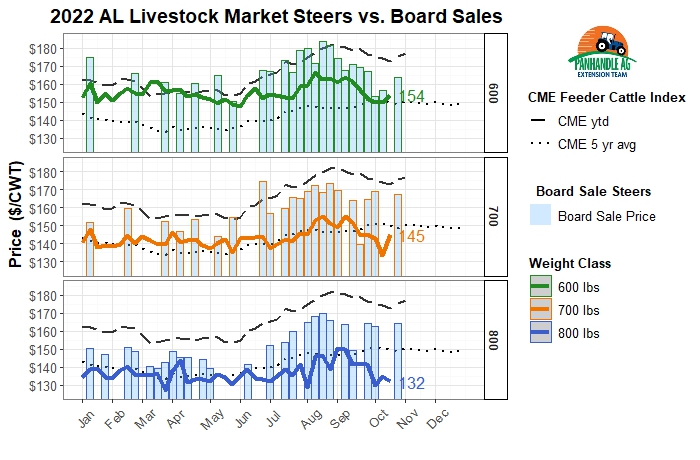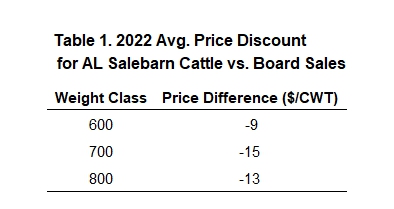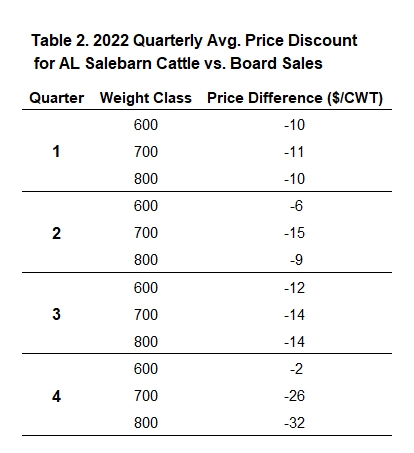It is no surprise to folks in cattle industry in the Southeast that more often than not feeder cattle and calves in the Deep South are sold at a relatively discounted price compared to market prices in states more central to cattle feeding regions in Midwestern and Western States. This price difference is referred to as basis. Generally defined as the difference in local cash price vs. expected futures market prices. Basis for feeder cattle in the South is influenced by many different factors. However, one of the most impactful factors for Southeastern feeder cattle basis is simply the transportation costs associated with shipping loads of cattle from the South to Mid-Western and Western states where the feedlot industry is centrally located.
–

Figure 1. 2022 Weekly Average Alabama Livestock Market Prices for 600, 700, & 800 weight steers as reported by the USDA weekly Alabama Livestock Market News, accessed via the My Market News API (https://marsapi.ams.usda.gov/), 5 year average CME feeder index prices, and current year to date feeder cattle index prices.
–
We can see an example representation of this year’s basis for various weight classes of cattle marketed in Alabama livestock markets by comparing those average prices (colored lines on the graph) with this year’s CME feeder cattle index (dashed line) as shown in figure 1 above.
–
Differences in Local Livestock Market Prices vs. Regional Board Sales
In addition to the price differences we experience in the South, due to regional basis, there are price differences among various marketing venues available to cattle producers in the Panhandle of Florida and adjacent areas of Alabama, and Georgia. In the following figures, I will compare average livestock market prices reported in the weekly Alabama Livestock Market News to average prices from regional board sales that are held throughout the year, including Mosely Livestock Feeder Cattle Board Sales (Blakely, GA), Southeast Alabama Feeder Cattle Association Board Sales (S.A.F.E.), and Seminole Livestock Exchange Board Sales (Donalsonville, GA). I hope to answer the question, what is the price difference between cattle marketed at Alabama weekly sale barn auctions vs. those at regional board sales? As well as discuss implications of those differences for management decisions for producers in different situations.

Figure 2. 2022 Weekly Average Alabama Livestock Market Prices for 600, 700, & 800 weight steers as reported by the USDA weekly Alabama Livestock Market News and Board Sales hosted by Mosely Livestock (Blakely, GA), Southeast Alabama Feeder Cattle Association (S.A.F.E.), and Seminole Livestock Exchange (Donalsonville, GA). Data accessed via the My Market News API (https://marsapi.ams.usda.gov/).
–
 When we tease out the price differences into groups by weight class, the price discounts for different sizes of cattle experienced at Alabama sale barns (prices represented by colored lines on the graph) vs. regional board sales (represented by bars on the graph) is fairly easy to see. Independent of weight class, earlier this year price differences where often not as different as later in the year (late summer to fall) when many seasonal feeder cattle board sales occur. In general, lighter cattle marketed at the sale barn had prices closer to board sale prices for cattle of the same size as compared to heavier cattle. Averaged across the entire year, sale barn marketed 600, 700, & 800 weight steers were sold $9, $15, and $13 less per hundredweight, compared to cattle of the same corresponding weight classes sold in board sales (Table 1). This translates to a $54, $105, & $104 value per head discount.
When we tease out the price differences into groups by weight class, the price discounts for different sizes of cattle experienced at Alabama sale barns (prices represented by colored lines on the graph) vs. regional board sales (represented by bars on the graph) is fairly easy to see. Independent of weight class, earlier this year price differences where often not as different as later in the year (late summer to fall) when many seasonal feeder cattle board sales occur. In general, lighter cattle marketed at the sale barn had prices closer to board sale prices for cattle of the same size as compared to heavier cattle. Averaged across the entire year, sale barn marketed 600, 700, & 800 weight steers were sold $9, $15, and $13 less per hundredweight, compared to cattle of the same corresponding weight classes sold in board sales (Table 1). This translates to a $54, $105, & $104 value per head discount.
 Unfortunately, when we break down those price differences into different quarters of the year, we can see the discounts can be much more severe than those annual averages. Lately in the past month, as can be seen in figure 2 (above) and table 2 (right), 800 lb feeder cattle are showing average discounts of $32 per hundredweight—a whopping $256 per head price reduction compared to similar weight animals sold in board sales. If one multiplies that $256 per head across even a small herd of feeder cattle, that quickly can become a significant chunk of money. Perhaps this recent price difference is just a short-term anomaly, perhaps not. In any case, it is a reminder of the potential economic impacts of how one markets their cattle.
Unfortunately, when we break down those price differences into different quarters of the year, we can see the discounts can be much more severe than those annual averages. Lately in the past month, as can be seen in figure 2 (above) and table 2 (right), 800 lb feeder cattle are showing average discounts of $32 per hundredweight—a whopping $256 per head price reduction compared to similar weight animals sold in board sales. If one multiplies that $256 per head across even a small herd of feeder cattle, that quickly can become a significant chunk of money. Perhaps this recent price difference is just a short-term anomaly, perhaps not. In any case, it is a reminder of the potential economic impacts of how one markets their cattle.
So, what do these price differences at livestock markets vs. board sales mean for you as a cattle producer, and can you do anything about it? If you have interest in marketing your calves through board sales there may be some management changes you need to make. Cattle marketed through board sales are generally expected to be in uniform groups, have health/vaccination records, be backgrounded on feed for a time after weaning, etc. Other examples of management changes that may be necessary for facilitating ability to participate in a board sales could include estrous synchronization of cows for a tighter calving season and/or potentially herd expansion to be able to assemble larger groups of calves attractive to potential buyers. For more information on one example of a regional board sale and expectations for how to participate see:
–
SE Alabama & SW Georgia SAFE Cattle Marketing Association Sale Results
–
Adding Value to Weaned Calves through Preconditioning and Cooperative Board Sales
–
Worth it for Your Operation?
To know if making these changes to be able to participate in board sales are worth implementing on your operation I would ask: Is $256 more per head (for 800lb steers in the past month) worth making those changes for you? Take note that this is perhaps a bit of an extreme, although real example. However, using more conservative average price differences like those presented table 1, one could pencil out the costs associated with making the management changes needed to market calves in board sales to if those corresponding cattle price premiums were worth it for your individual situation. As with any market, those values are likely to change, so paying attention to updated market prices will give you a better idea of how those price differences may be panning out into the future.
Perhaps in your case making those changes to market your animals in a board sale may not be feasible. There are still things you can do to get the most from their calves marketed at the local livestock market. The following are previously published articles that discuss these options:
–
Increasing Income from Calves Sold at your Local Livestock Market
–
Enhancing the Market Value of Your Next Calf Crop
–
Maximizing Revenue with Calf Management
–
Factors That Affect Calf Selling Price at Marketing
- Silvopasture 101 Workshop and Farm Tour Recap - May 3, 2024
- What does the Future Hold for your Farm or Ranch? - November 3, 2023
- The Lowdown on Belowground – Pasture Grass Roots - May 19, 2023
